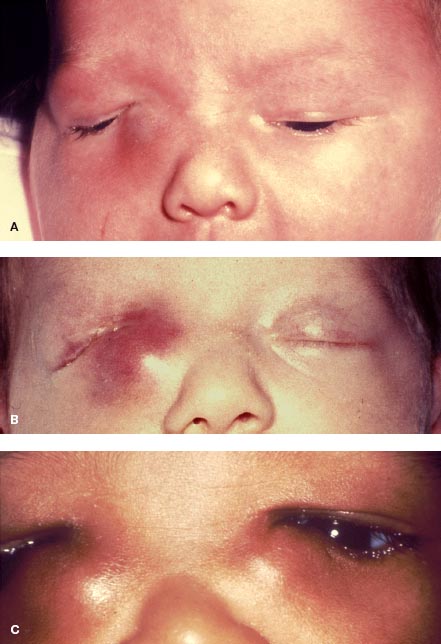8
Lacrimal Anomalies
Leonard B. Nelson and Harold P. Koller 
CONGENITAL MUCOCELE
 When an obstruction at the upper and lower portions of the lacrimal system occurs, fluid accumulates and causes a distention of the lacrimal sac at birth, termed a mucocele.
When an obstruction at the upper and lower portions of the lacrimal system occurs, fluid accumulates and causes a distention of the lacrimal sac at birth, termed a mucocele.
Etiology
 Sporadic
Sporadic
 Concomitant blockage at the valve of Rosenmüller and in the nasolacrimal duct leads to the formation of lacrimal sac mucoceles.
Concomitant blockage at the valve of Rosenmüller and in the nasolacrimal duct leads to the formation of lacrimal sac mucoceles.
Symptoms
 Tearing
Tearing
 Difficulty breathing
Difficulty breathing
 Difficulty with breastfeeding on the mother’s breast ipsilateral to the mucocele
Difficulty with breastfeeding on the mother’s breast ipsilateral to the mucocele
Signs
 Blue-gray swelling inferior to the medial canthal tendon at birth (Fig. 8-1).
Blue-gray swelling inferior to the medial canthal tendon at birth (Fig. 8-1).
 Secondary infection (erythema of the tissues overlying the lacrimal sac) may occur.
Secondary infection (erythema of the tissues overlying the lacrimal sac) may occur.
 Mucocele may extend intranasally as a submucocele mass along the nasal floor beneath the inferior turbinate.
Mucocele may extend intranasally as a submucocele mass along the nasal floor beneath the inferior turbinate.
Differential Diagnosis
 Hemangioma
Hemangioma
 Dermoid
Dermoid
 Encephalocele
Encephalocele
 Nasal glioma
Nasal glioma
Treatment
 Conservative management includes gentle massage and warm compresses.
Conservative management includes gentle massage and warm compresses.
 Dacryocystitis can develop within a few days or weeks and requires systemic antibiotics.
Dacryocystitis can develop within a few days or weeks and requires systemic antibiotics.
 Ultimately, if the mucocele cannot be decompressed with massage, within several days, prompt probing has been recommended. Rarely, serious complications of central nervous system infections have been reported; therefore, some have recommended early probing.
Ultimately, if the mucocele cannot be decompressed with massage, within several days, prompt probing has been recommended. Rarely, serious complications of central nervous system infections have been reported; therefore, some have recommended early probing.
Prognosis
 The resolution rate with conservative management is approximately 76%.
The resolution rate with conservative management is approximately 76%.
 If probing is necessary, resolution can be accomplished.
If probing is necessary, resolution can be accomplished.
REFERENCES
Harris GJ, DiClementi D. Congenital dacryocystocele. Arch Ophthalmol. 1982;100:1763–1765.
Schnall BM, Christain CJ. Conservative treatment of congenial dacryocele. J Pediatr Ophthal Strabismus. 1996;33:219–222.
Wong RK, VanderVeen DK. Presentation and management of congenital dacryocystocele. Pediatrics. 2008;122:1108–1112.
Figure 8-1. A. Mucocele of the nasolacrimal system showing swelling and mild erythema. B. Mucocele showing more significant swelling and erythema. C. Bilateral mucoceles.

Stay updated, free articles. Join our Telegram channel

Full access? Get Clinical Tree


